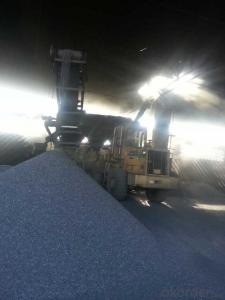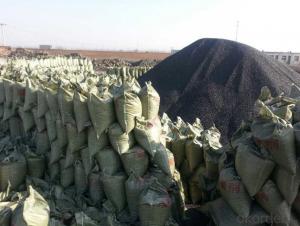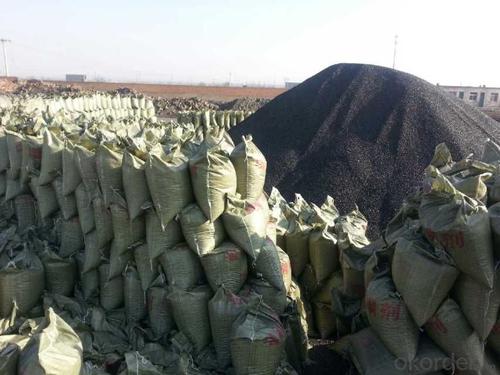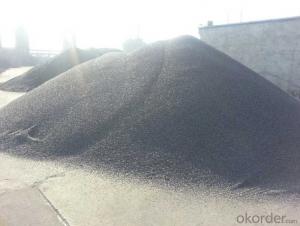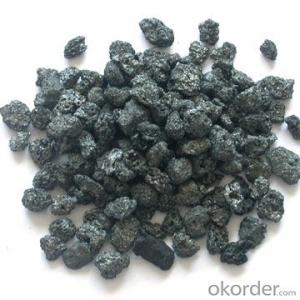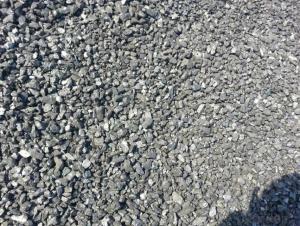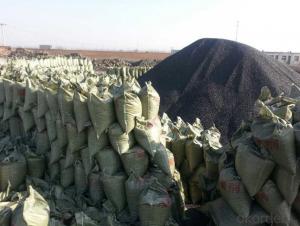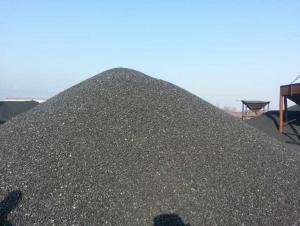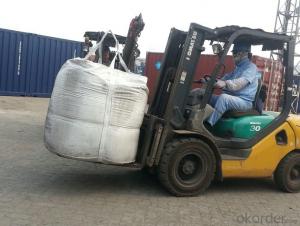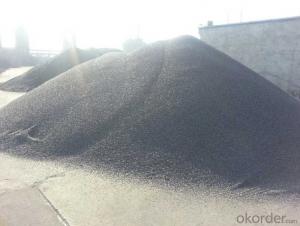Injection Coke FC85% min with stable quality
- Loading Port:
- Tianjin
- Payment Terms:
- TT OR LC
- Min Order Qty:
- 20 m.t.
- Supply Capability:
- 3000 m.t./month
OKorder Service Pledge
OKorder Financial Service
You Might Also Like
Packaging & Delivery
25kgs/50kgs/1ton per bag or as buyer's request
Specifications
Calcined Anthracite
Fixed carbon: 90%-95%
S: 0.5% max
Size: 0-3. 3-5.3-15 or as request
It used the high quality anthracite as raw materials through high temperature calcined at over 2000 by the DC electric calciner with results in eliminating the moisture and volatile matter from anthracite efficiently, improving the density and the electric conductivity and strengthening the mechanical strength and anti-oxidation. It has good characteristics with low ash, low resistvity, low sulphur, high carbon and high density. It is the best material for high quality carbon products.
Advantage and competitive of caclined anthracite:
1. strong supply capability
2. fast transportation
3. lower and reasonable price for your reference
4.low sulphur, low ash
5.fixed carbon:95% -90%
6..sulphur:lower than 0.3%
General Specification of Calcined Anthracite:
| FC | 80% | 83% | 85% | 88% | 90% |
| ASH % | 16 | 14 | 13 | 10 | 8.5 |
| V.M. % | 3 | 3 | 2 | 2 | 1.5 |
| S % | 0.5 | 0.5 | 0.5 | 0.5 | 0.35 |
| MOISTURE % | 2 | 2 | 1 | 1 | 0.5 |
Pictures
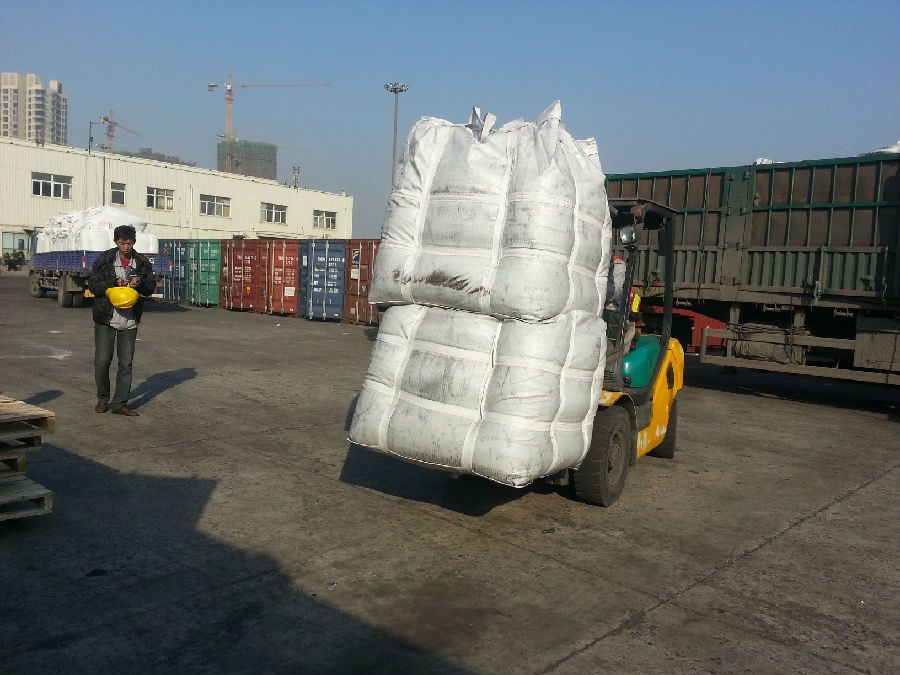
- Q: What are the consequences of increased carbon emissions on coral reefs?
- Coral reefs are severely impacted by the increased emission of carbon, resulting in numerous consequences. One major effect is the occurrence of ocean acidification, which happens when excess carbon dioxide is absorbed by seawater, causing a decrease in pH levels. This acidification hampers the ability of corals to construct their calcium carbonate skeletons, making them more susceptible to erosion and breakage. Moreover, elevated levels of carbon dioxide in the atmosphere contribute to global warming, leading to the rise of ocean temperatures. Consequently, coral bleaching occurs as corals expel the symbiotic algae responsible for their vibrant colors. Without these algae, corals become stressed, lose their color, and become more vulnerable to disease and death. Additionally, increased carbon emissions contribute to alterations in ocean currents and weather patterns, resulting in more frequent and intense storms. These storms physically damage coral reefs, causing further destruction to already fragile ecosystems. The consequences of increased carbon emissions on coral reefs are profound and devastating. The decline of coral reefs not only impacts the biodiversity of the oceans but also has significant implications for human populations that rely on reefs for sustenance, income, coastal protection, and tourism. It is imperative to reduce carbon emissions and take immediate action to safeguard and preserve these invaluable ecosystems.
- Q: Where do I buy DNF premium advanced carbon?
- Before in the mall to buy, now advanced has been officially cancelled only in the network, the old machine and rock strengthening reinforcement, carbon furnace has been canceled, now can only rely on colorless strengthening, but to strengthen and improve the success rate of the previous 10 carbon furnace rock will burst, now with a colorless hundred won't burst. So please accept, quack quack!
- Q: What are the impacts of carbon emissions on natural disasters?
- Carbon emissions contribute to the intensification and frequency of natural disasters. The release of greenhouse gases, such as carbon dioxide, traps heat in the atmosphere, leading to global warming and climate change. This warmer climate alters weather patterns, resulting in more frequent and severe events like hurricanes, droughts, wildfires, and floods. Additionally, the melting of polar ice caps due to increased temperatures raises sea levels, making coastal regions more vulnerable to storm surges and causing further devastation. Overall, carbon emissions exacerbate the impact of natural disasters, posing significant threats to human lives, ecosystems, and economies.
- Q: What are carbon-based superconductors?
- Superconductivity, a phenomenon where electrical resistance drops to zero at low temperatures, is exhibited by carbon-based superconductors. Unlike conventional superconductors, which are typically metallic elements or alloys, carbon-based superconductors are primarily composed of carbon atoms. These materials possess a unique structure and properties that make them efficient conductors of electricity when cooled below a critical temperature. Carbon-based superconductors can be divided into two main types: organic superconductors and fullerene superconductors. Organic superconductors consist of carbon-based molecules, such as organic salts or polymers, that form a crystal lattice structure. Extensive research has been conducted on these materials, revealing promising superconducting properties at low temperatures. On the other hand, fullerene superconductors are composed of carbon molecules arranged in a cage-like structure called fullerenes. The most famous fullerene is C60, also known as a buckyball, which has 60 carbon atoms arranged in a soccer ball-like shape. By doping these fullerene cages with specific elements like alkali metals or transition metals, their superconducting properties can be enhanced. What makes carbon-based superconductors particularly fascinating is their potential for high-temperature superconductivity. While most conventional superconductors require extremely low temperatures close to absolute zero (-273.15°C or -459.67°F) to exhibit superconductivity, certain carbon-based superconductors have been found to retain their superconducting properties at relatively higher temperatures. This characteristic is significant for practical applications as it facilitates easier cooling and opens up possibilities for widespread use of superconductivity in fields like energy transmission, magnetic levitation, and quantum computing. However, it is crucial to note that carbon-based superconductors are still an active research area, and numerous challenges remain in understanding their mechanisms and enhancing their superconducting properties. Nevertheless, the discovery and exploration of these materials hold great promise for advancing the field of superconductivity and enabling new technological breakthroughs.
- Q: What are the different types of carbon-based plastics?
- Carbon-based plastics come in various types, each possessing distinct characteristics and uses. Among the commonly known variants are: 1. Polyethylene (PE): This plastic, available in high-density polyethylene (HDPE) and low-density polyethylene (LDPE) forms, is widely employed due to its strength, flexibility, and resistance to chemicals. It finds applications in packaging, pipes, and toys. 2. Polypropylene (PP): Renowned for its high melting point, chemical resistance, and durability, PP is a popular choice for automotive parts, appliances, and packaging. 3. Polystyrene (PS): PS, a rigid plastic, frequently features in disposable products like food containers and packaging materials. Its lightweight nature and good insulation properties make it advantageous. 4. Polyvinyl Chloride (PVC): PVC, a versatile plastic that can be flexible or rigid based on its composition, sees wide usage in construction materials, pipes, cables, and vinyl flooring. 5. Polyethylene Terephthalate (PET): PET, a lightweight and sturdy plastic, is commonly employed in beverage bottles, food packaging, and textile fibers. It is renowned for its exceptional resistance to gas and moisture. 6. Polycarbonate (PC): PC, a transparent plastic, stands out for its high resistance to impact and heat. It is often utilized in eyewear, automotive parts, and electronic devices. These examples represent just a fraction of the carbon-based plastics available in the market. Numerous other variations and blends exist, and the choice of plastic depends on factors such as intended application, desired properties, and environmental considerations.
- Q: How is carbon used in the production of nanoelectronics?
- The production of nanoelectronics involves the diverse utilization of carbon. One of the most notable applications is seen in the creation of carbon nanotubes (CNTs), which are cylindrical structures composed solely of carbon atoms. These nanotubes possess exceptional electrical and mechanical properties that render them highly suitable for incorporation into nanoelectronic devices. CNTs can serve as transistors, which serve as the fundamental building blocks of electronic circuits. Due to their diminutive size and outstanding electrical conductivity, CNT transistors have the capacity to generate high-performance, low-power devices. Consequently, they hold the potential to supplant conventional silicon transistors, thus enabling the development of more sophisticated and compact electronic devices. In addition, carbon plays a pivotal role in the production of graphene, a single layer of carbon atoms arranged in a two-dimensional honeycomb lattice. Graphene exhibits extraordinary electrical conductivity, thermal conductivity, and mechanical strength. Consequently, it can function as a conductive material in nanoelectronics, thereby facilitating the creation of swifter and more efficient electronic devices. Moreover, carbon-based materials can be employed in nanoelectronics for energy storage purposes. For example, carbon nanotubes and graphene can be harnessed in supercapacitors, energy storage devices that possess the ability to rapidly store and discharge substantial amounts of electrical energy. These carbon-based energy storage systems hold the potential to revolutionize the realm of portable electronics and electric vehicles. In conclusion, the extensive utilization of carbon in the production of nanoelectronics can be observed. Its distinctive properties, including heightened electrical conductivity, mechanical strength, and thermal conductivity, render it an ideal material for the advancement of high-performance electronic devices. Carbon nanotubes, graphene, and other carbon-based materials serve as crucial components in the fabrication of nanoelectronic devices, thereby enabling progress in computing power, energy storage, and the miniaturization of electronic components.
- Q: What is the basic principle of carbon fourteen detection?
- There are 3 kinds of carbon isotopes in nature, and their weight ratio is 12:13:14. They are expressed by carbon -12, carbon -13 and carbon -14 respectively. The first two are stable isotopes. Carbon -14 is radioactive. It exists in the atmosphere and is generated in the upper atmosphere by cosmic rays, neutrons, and atmospheric nitrogen nuclei. It combines C4O2 molecules with oxygen in the atmosphere, which is the same as carbon dioxide (CO2). Therefore, it mixes with carbon dioxide to participate in the natural carbon exchange movement. It is absorbed by plants by photosynthesis and stored in plants. People and animals need to eat plants, so they are also stored in human and animal bodies. During the life of the organism, they continuously acquire the radioactive carbon from the atmosphere. But when an animal or plant dies, it stops absorbing and reduces the radioactive carbon in the body. For about 5730 years, its content could be attenuated by half. So physicists call the half-life 5730 years. Therefore, as long as the instruments to measure the trees, grain, animal bones and bone biological remains in the existing carbon content of -14, compared with its original carbon -14 level, you can calculate their death in many years ago, which can be inferred and their coexistence remains (such as construction sites, tombs or other relics how many years have elapsed since).Pro, please [adopted the answer], your adoption is the driving force for my answer, thank you.
- Q: What is carbon offsetting in the hospitality industry?
- The hospitality industry engages in carbon offsetting as a means of counteracting the greenhouse gas emissions generated by hotels, resorts, and other businesses in the sector. This practice serves to offset the carbon footprint resulting from various activities within the industry, including energy consumption, transportation, waste management, and water usage. To engage in carbon offsetting, hospitality establishments first calculate the quantity of carbon dioxide or other greenhouse gases they emit. They then invest in projects aimed at reducing emissions in other locations. Examples of such projects include initiatives focused on renewable energy, reforestation, or energy efficiency. Through supporting these projects, the hospitality industry strives to offset or neutralize its own carbon emissions and thereby minimize its impact on climate change. Hotels and resorts have the option to purchase carbon offsets from specialized organizations that facilitate carbon offset projects. These organizations ensure that the offsets are verified and adhere to recognized standards, such as the Verified Carbon Standard or the Gold Standard. By investing in verified offsets, the hospitality industry can have confidence that their contributions effectively contribute to reducing global greenhouse gas emissions. Carbon offsetting in the hospitality industry not only showcases environmental responsibility but also offers economic advantages. A growing number of travelers are increasingly conscious of the environmental consequences associated with their accommodation choices. As a result, they actively seek out hotels and resorts that prioritize sustainability. By implementing carbon offsetting programs, hospitality businesses can attract environmentally conscious guests and stand out in a competitive market. Moreover, carbon offsetting is just one component of a wider sustainability strategy within the hospitality industry. Many hotels and resorts are also adopting energy-efficient practices, implementing waste reduction measures, and promoting water conservation. By combining these efforts with carbon offsetting initiatives, the hospitality industry can contribute to a more sustainable future while simultaneously improving their financial performance. In conclusion, carbon offsetting in the hospitality industry involves investing in projects that reduce greenhouse gas emissions in order to compensate for the carbon footprint generated by hotels and resorts. This practice enables the industry to nullify its environmental impact and demonstrate a commitment to sustainability. Through the implementation of carbon offsetting programs, the hospitality industry can attract environmentally conscious guests, differentiate itself in the market, and contribute to a more sustainable future.
- Q: What are the effects of carbon emissions on the stability of desertification?
- Carbon emissions contribute to the stability of desertification by exacerbating its effects. Increased atmospheric carbon dioxide levels lead to global warming, which in turn intensifies droughts and reduces precipitation in arid regions. This prolonged dryness accelerates soil degradation, reduces vegetation cover, and undermines the ability of arid ecosystems to sustain life. Therefore, carbon emissions play a significant role in destabilizing desertification processes and further threatening the stability of arid landscapes.
- Q: How is carbon used in the production of paints?
- Carbon is used in the production of paints as a pigment or coloring agent. Carbon black, which is made from the incomplete combustion of petroleum products, is commonly used to provide a deep black color to paints. It is also used in the form of graphite to create black or gray shades. Additionally, carbon-based materials like activated charcoal are used as fillers or extenders in certain types of paints.
Send your message to us
Injection Coke FC85% min with stable quality
- Loading Port:
- Tianjin
- Payment Terms:
- TT OR LC
- Min Order Qty:
- 20 m.t.
- Supply Capability:
- 3000 m.t./month
OKorder Service Pledge
OKorder Financial Service
Similar products
Hot products
Hot Searches
Related keywords
